Navigation
Wild Dolphin Project Contributes to Understanding of Atlantic Spotted and Bottlenose Dolphins
Through their research, the Wild Dolphin Project has learned a great deal of information about spotted and bottlenose dolphins, which has greatly contributed to the scientific understanding of these species.
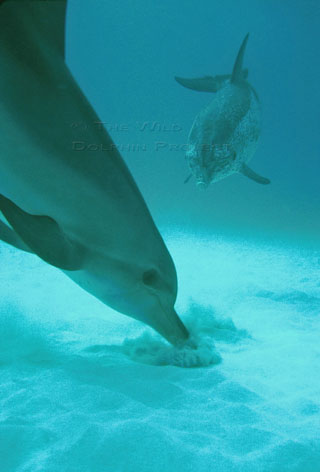 |
| A two-toned Atlantic Spotted Dolphin foraging. Photo by Wild Dolphin Project |
Through their research, the Wild Dolphin Project has learned a great deal of information about spotted and bottlenose dolphins, which has greatly contributed to the scientific understanding of these species. In order to understand the lives of Atlantic spotted and bottlenose dolphins through a non-invasive long-term study, “In Their World, on Their Terms”, the Wild Dolphin Project (WDP) has been researching the same pod of Atlantic spotted dolphins, Stenella frontalis, in the Bahamas for over 23 years.
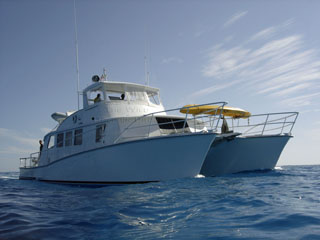 |
| The Wild Dolphin Project works aboard Research Vessel Stenella to gather data on the dolphins.Photo by Wild Dolphin Project |
Every summer, from May – September, the scientists, along with colleagues and paying passengers, board the project’s research vessel, R/V Stenella – a 62’ power catamaran. Stenella becomes a live aboard lab and field station during these research trips where the clear waters of the Bahamas offer a unique chance to view dolphin behavior underwater.
It is critical to understand who the players are to interpret behaviors in a social context; therefore it is vital to be able to identify individuals.
Spotted dolphins gain spots as they get older, allowing researchers to identify and track individuals over years (through photo-identification), as well as determine their sex and what age class they belong to: calf, juvenile, young adult and adult.
Some of the dolphins have been tracked since the project began in 1985. WDP has been able to learn about their life histories, behaviors, social structure and communication systems, revealing a great deal of information about these complex social mammals.
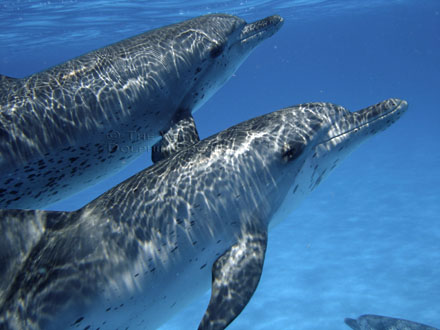 |
| Two male speckled Atlantic Spotted Dolphins pec rubbing. Photo by Wild Dolphin Project |
Another unique aspect of this project is that these Atlantic spotted dolphins are sympatric (they live in the same area and have to share resources) with Atlantic bottlenose dolphins (Tursiops truncatus). Through photo-identification, the bottlenose dolphins are identified and tracked by observing nicks and scars on their dorsal fin. This gives WDP the rare opportunity to study long-term interspecies interactions, with known individuals of both species involved.
WDP strives to use new technology, software and ideas as they emerge, to improve upon their research.
Recent developments include high frequency recording equipment (dolphins can produce sounds high above our hearing and recording range, but this equipment allows researchers to capture these high frequency vocalizations), non-invasive genetic sampling and analysis (researchers collect fecal samples in the water, then the DNA is extracted and analyzed), Geographic Information Systems (GIS) software packages (mapping), and new software programs in social analysis.
With these new tools researchers can analyze dolphin sounds that can’t be heard, determine paternity of individuals (the fathers of individuals are unknown) and genetic structuring of the population, map dolphin sightings and correlate those with environmental data, and better and more accurately describe their social structure.
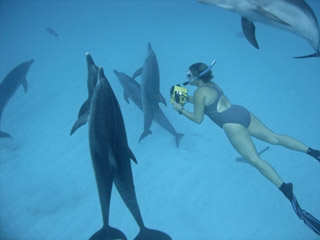 |
| Dr. Denise Herzing, Research Director/Founder of The Wild Dolphin Project videotapes a group of Atlantic Spotted Dolphins underwater. Dr. Denise Herzing was recently recognized by the John Simon Guggenheim Foundation as a 2008 Fellow for her continued research and documentation of the Atlantic spotted dolphin. Photo by Wild Dolphin Project |
WDP is dedicated to research, education and conservation. Through their research WDP has learned a great deal of information about spotted and bottlenose dolphins, which has greatly contributed to the scientific understanding of these species. For example, both species have similar social structures compared with other coastal bottlenose dolphin populations; males have strong bonds termed alliances, and females form relationships depending on their reproductive status (you need help when raising calves!). Females give birth for the first time around 9-10 years of age (young adult age class) and have calves about every 3 years.
WDP has correlated sounds with behaviors, learning that certain vocalizations are used in socialization and that many are correlated with particular behaviors. The two species spend about 15% of their time together, often in aggressive interactions, where bottlenose dolphins dominate the spotted dolphins.
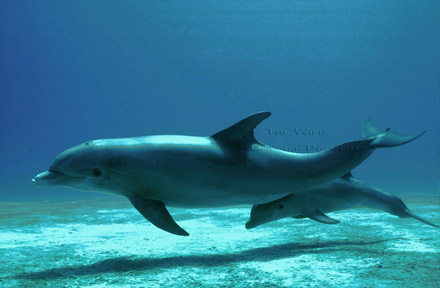 |
| Atlantic Bottlenose mother/calf pair. Photo by Wild Dolphin Project |
The knowledge obtained through a long-term study such as this is crucial in order to help protect and conserve these species, other dolphin species and the ocean they inhabit.
Education is also important. The public can have profound effects on legislation and conservation efforts. WDP gives lectures (for kids, teens and adults) and prepares materials for classes in an effort to educate people on dolphins, and the specific pod they study located just 50+ miles off the southeast Florida coast.
Through research and education, conservation of species can be realized, and this is primary goal of the Wild Dolphin Project.
If you would like to learn more about The Wild Dolphin Project, download scientific articles, children’s activities or want to learn about becoming a boat participant, please visit their website: www.wilddolphinproject.org. The website provides lists and links to articles and TV shows/documentaries.
Follow-up Strategy:
Continued long-term research on the Atlantic spotted and bottlenose dolphins. This is necessary for documentation of continued changes in the environment and the species.
Note:
"The project was founded in 1985 by Dr. Denise Herzing. The goals of the project are research, education and conservation. By learning about the lives of these complex social animals and sharing that knowledge with scientists and public alike, we can improve conservation efforts and help protect dolphins and the oceans they inhabit."
Contact: The Wild Dolphin Project
The Wild Dolphin Project
P.O. Box 8436
Jupiter, FL 33468
USA
Phone: (1) 561-575-5660
Fax: (1) 561-575-5681
Kali Dambeck, Development Director
kdambeck@wilddolphinproject.
Cindy Rogers, Research Assistant
crogers@wilddolphinproject.org
Submitted by: The Wild Dolphin Project
Search
Latest articles
Agriculture
- World Water Week: Healthy ecosystems essential to human health: from coronavirus to malnutrition Online session Wednesday 24 August 17:00-18:20
- World Water Week: Healthy ecosystems essential to human health: from coronavirus to malnutrition Online session Wednesday 24 August 17:00-18:20
Air Pollution
- "Water and Sanitation-Related Diseases and the Changing Environment: Challenges, Interventions, and Preventive Measures" Volume 2 Is Now Available
- Global Innovation Exchange Co-Created by Horizon International, USAID, Bill and Melinda Gates Foundation and Others
Biodiversity
- World Water Week: Healthy ecosystems essential to human health: from coronavirus to malnutrition Online session Wednesday 24 August 17:00-18:20
- Mangrove Action Project Collaborates to Restore and Preserve Mangrove Ecosystems
Desertification
- World Water Week: Healthy ecosystems essential to human health: from coronavirus to malnutrition Online session Wednesday 24 August 17:00-18:20
- UN Food Systems Summit Receives Over 1,200 Ideas to Help Meet Sustainable Development Goals
Endangered Species
- Mangrove Action Project Collaborates to Restore and Preserve Mangrove Ecosystems
- Coral Research in Palau offers a “Glimmer of Hope”
Energy
- Global Innovation Exchange Co-Created by Horizon International, USAID, Bill and Melinda Gates Foundation and Others
- Wildlife Preservation in Southeast Nova Scotia
Exhibits
- Global Innovation Exchange Co-Created by Horizon International, USAID, Bill and Melinda Gates Foundation and Others
- Coral Reefs
Forests
- NASA Satellites Reveal Major Shifts in Global Freshwater Updated June 2020
- Global Innovation Exchange Co-Created by Horizon International, USAID, Bill and Melinda Gates Foundation and Others
Global Climate Change
- World Water Week: Healthy ecosystems essential to human health: from coronavirus to malnutrition Online session Wednesday 24 August 17:00-18:20
- Mangrove Action Project Collaborates to Restore and Preserve Mangrove Ecosystems
Global Health
- World Water Week: Healthy ecosystems essential to human health: from coronavirus to malnutrition Online session Wednesday 24 August 17:00-18:20
- More than 400 schoolgirls, family and teachers rescued from Afghanistan by small coalition
Industry
- "Water and Sanitation-Related Diseases and the Changing Environment: Challenges, Interventions, and Preventive Measures" Volume 2 Is Now Available
- Global Innovation Exchange Co-Created by Horizon International, USAID, Bill and Melinda Gates Foundation and Others
Natural Disaster Relief
- STOP ATTACKS ON HEALTH CARE IN UKRAINE
- Global Innovation Exchange Co-Created by Horizon International, USAID, Bill and Melinda Gates Foundation and Others
News and Special Reports
- World Water Week: Healthy ecosystems essential to human health: from coronavirus to malnutrition Online session Wednesday 24 August 17:00-18:20
- STOP ATTACKS ON HEALTH CARE IN UKRAINE
Oceans, Coral Reefs
- World Water Week: Healthy ecosystems essential to human health: from coronavirus to malnutrition Online session Wednesday 24 August 17:00-18:20
- Mangrove Action Project Collaborates to Restore and Preserve Mangrove Ecosystems
Pollution
- Zakaria Ouedraogo of Burkina Faso Produces Film “Nzoue Fiyen: Water Not Drinkable”
- "Water and Sanitation-Related Diseases and the Changing Environment: Challenges, Interventions, and Preventive Measures" Volume 2 Is Now Available
Population
- "Water and Sanitation-Related Diseases and the Changing Environment: Challenges, Interventions, and Preventive Measures" Volume 2 Is Now Available
- "Water and Sanitation-Related Diseases and the Changing Environment: Challenges, Interventions, and Preventive Measures" Volume 2 Is Now Available
Public Health
- Honouring the visionary behind India’s sanitation revolution
- Honouring the visionary behind India’s sanitation revolution
Rivers
- World Water Week: Healthy ecosystems essential to human health: from coronavirus to malnutrition Online session Wednesday 24 August 17:00-18:20
- Mangrove Action Project Collaborates to Restore and Preserve Mangrove Ecosystems
Sanitation
- Honouring the visionary behind India’s sanitation revolution
- Honouring the visionary behind India’s sanitation revolution
Toxic Chemicals
- "Water and Sanitation-Related Diseases and the Changing Environment: Challenges, Interventions, and Preventive Measures" Volume 2 Is Now Available
- Actions to Prevent Polluted Drinking Water in the United States
Transportation
- "Water and Sanitation-Related Diseases and the Changing Environment: Challenges, Interventions, and Preventive Measures" Volume 2 Is Now Available
- Urbanization Provides Opportunities for Transition to a Green Economy, Says New Report
Waste Management
- Honouring the visionary behind India’s sanitation revolution
- Honouring the visionary behind India’s sanitation revolution
Water
- Honouring the visionary behind India’s sanitation revolution
- Honouring the visionary behind India’s sanitation revolution
Water and Sanitation
- Honouring the visionary behind India’s sanitation revolution
- Honouring the visionary behind India’s sanitation revolution

